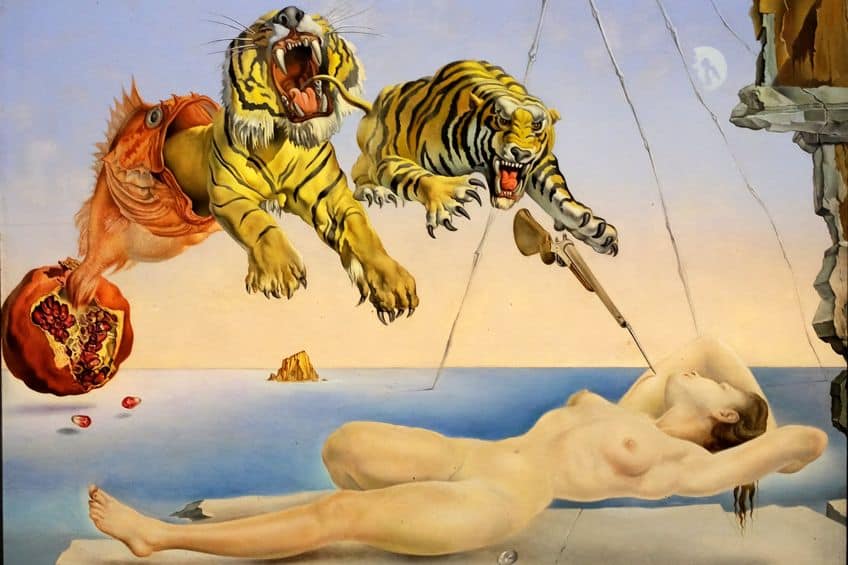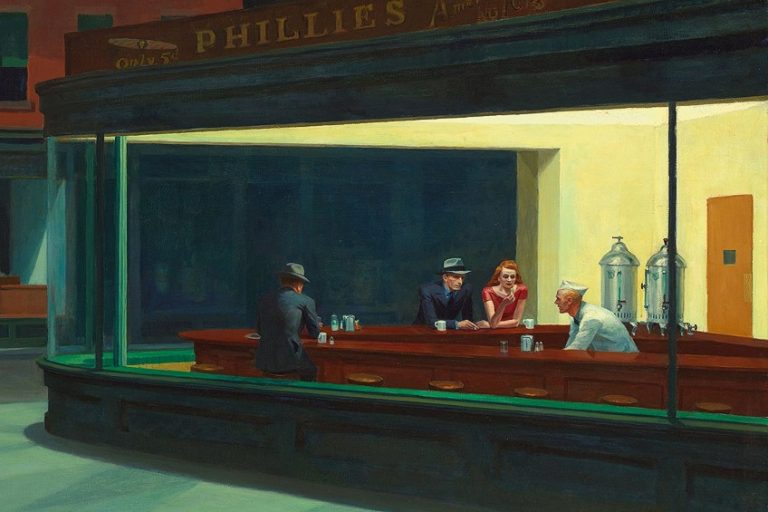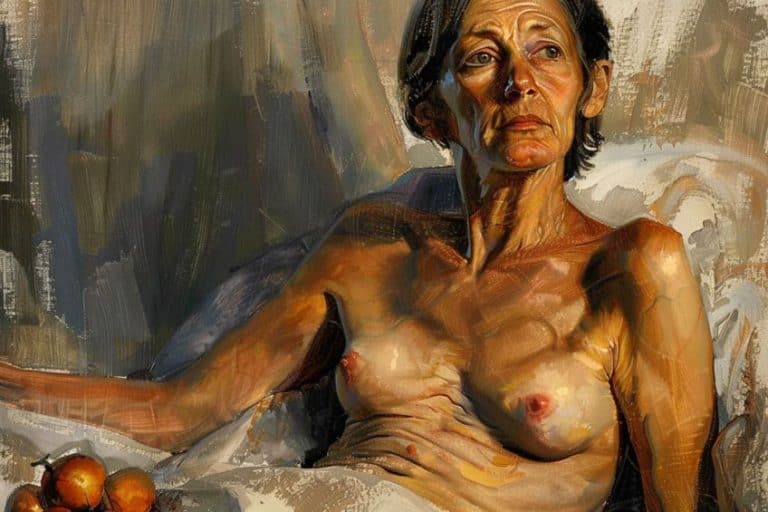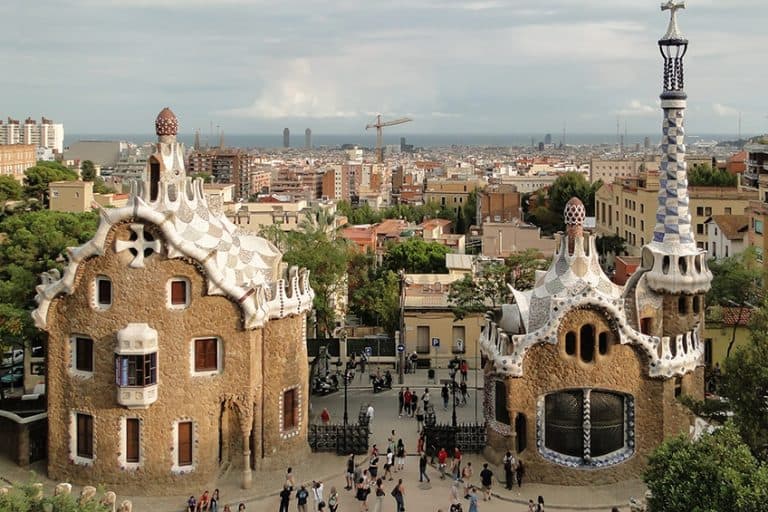“Dream Caused by the Flight of a Bee” by Salvador Dalí – Analysis
Salvador Dalí’s Dream Caused by the Flight of a Bee Around a Pomegranate a Second Before Awakening stands as a mesmerizing portrayal within the surrealist movement of the 20th century, illustrating Dalí’s profound intrigue with the depths of the subconscious mind. Painted in 1944, this piece portrays Dalí’s wife, Gala, as the central figure and invites viewers to explore dream imagery and the artist’s perception of the unconscious mind. The artwork features a combination of disparate elements such as a floating pomegranate, a bee, two airborne droplets of water, and a reclining figure suspended above a rock.
Key Takeaways
- Dalí’s painting exemplifies the surrealist movement and highlights his skill in depicting the subconscious mind.
- Dream Caused by the Flight of a Bee around a Pomegranate a Second Before Awakening is renowned for its lifelike detail and symbolic use of elements.
- The artwork presents a complex interplay of reality and dream, inviting analytical interpretation of its narrative and artistic techniques.
Artistic Context
| Artist | Salvador Dalí (1904 – 1989) |
| Date Created | 1944 |
| Medium | Oil on wood |
| Genre | Surrealism |
| Period/Movement | Surrealist movement |
| Dimensions (cm) | 51 x 40 |
| Series/Versions | N/A |
| Where Is It Housed? | Thyssen-Bornemisza National Museum, Madrid, Spain |
| What It Is Worth | Estimated to be in the millions |
The artwork titled Dream Caused by the Flight of a Bee Around a Pomegranate a Second Before Awakening showcases Salvador Dalí’s adept utilization of surrealist techniques and his exploration of Freudian dream analysis.
The composition invites viewers into a realm where reality and imagination blend seamlessly, offering a glimpse into Dalí’s fascination with the subconscious and his innovative approach to visual storytelling.

Surrealism and Dalí’s Vision
Salvador Dalí emerged as a notable figure within the surrealist art movement, which aimed to tap into the boundless creative reservoirs of the unconscious psyche. Surrealism emerged in the early 20th century, aiming to bridge the gap between dreams and reality. Dalí, known for his vivid and bizarre images, often employed the paranoiac-critical method, which he developed to access the subconscious and enhance the creative process. This technique allowed him to depict dream-like scenes with photographic precision.

Freud’s Influence and Dream Symbolism
Sigmund Freud’s psychoanalytical work significantly impacted Dalí, particularly the theory that art could be a manifestation of one’s unconscious desires and fears. Freud’s exploration of dream symbolism is evident in Dalí’s paintings, where ordinary objects are often laden with double meanings or altered in disturbing and irrational ways.
Dream Caused by the Flight of a Bee around a Pomegranate a Second Before Awakening is a quintessential example of this, illustrating a dream’s fleeting and irrational nature as well as the hidden symbolism within the unconscious mind.
Formal Analysis of the Painting
Salvador Dalí’s Dream Caused by the Flight of a Bee Around a Pomegranate a Second Before Awakening intricately weaves together symbolism and meticulous composition, offering a profound visual narrative. The subsections below explore the distinct elements of the subject matter, the use of imagery and symbolism, and Dalí’s masterful manipulation of color and composition within the painting.

Subject Matter and Symbolism
The central figure in the painting is Gala, Dalí’s wife and muse, depicted asleep on a flat rock. Her naked body is a stark contrast to the surreal scene around her, which includes elements like a bee, pomegranates, tigers, an elephant, a bayonet, and calm waters, each serving a specific symbolic role.
In the painting, various symbolic elements coalesce to convey intricate layers of meaning.
A small bee hovers near the pomegranate, evoking themes of fertility and industry, which resonate with the productive dreams that sleep may bring. The pomegranate itself serves as a symbol of resurrection and fertility, positioned near Gala’s head, suggesting the origins of her dreams and aspirations. Tigers, depicted emerging from the mouth of a fish with an aggressive leap, and the presence of a bayonet, symbolize the tumultuous themes of awakening and inner violence.
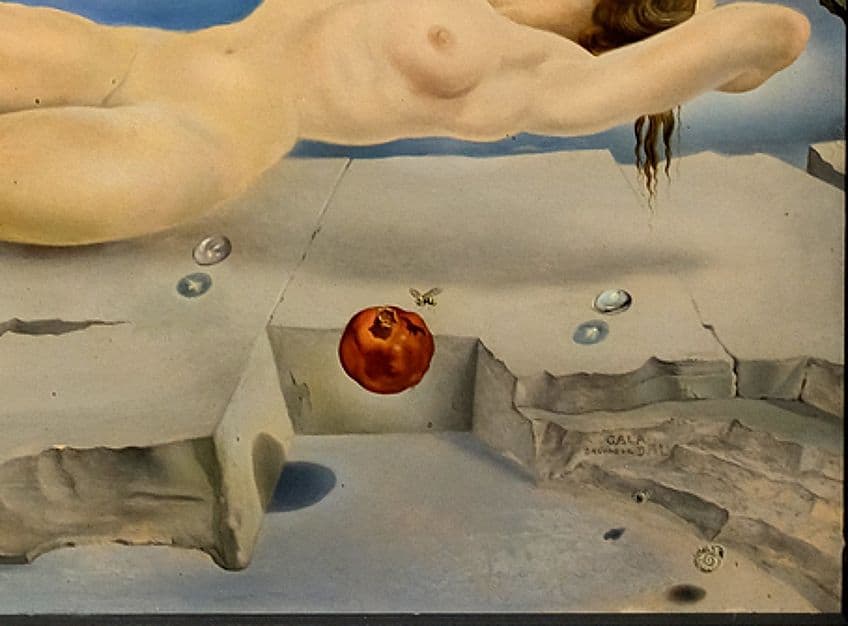
An elephant, characterized by long flamingo legs and bearing an obelisk, represents strength atop delicate supports, illustrating a contradiction that idealizes the harmony of existence. Although not directly visible in the painting, the presence of Venus is felt through her ethereal quality, which resonates with themes of fertility and admiration of the female form, adding another layer of depth to the artwork. Each symbol intertwines to enrich the narrative of the painting, inviting viewers to explore the complexities of the human experience.
Color and Composition
Dalí uses vibrant colors contrasting with dark shadows to create a dream-like atmosphere. The calm blue waters juxtaposed with the fiery hues of the tigers and the golden tones of the distant horizons evoke a sense of surreal serenity. Within the painting, each element holds its distinct position, contributing to the intricate symbolism woven throughout the composition.
Gala occupies the center stage, perched atop the rock, serving as the focal point of the piece, embodying significance and presence.
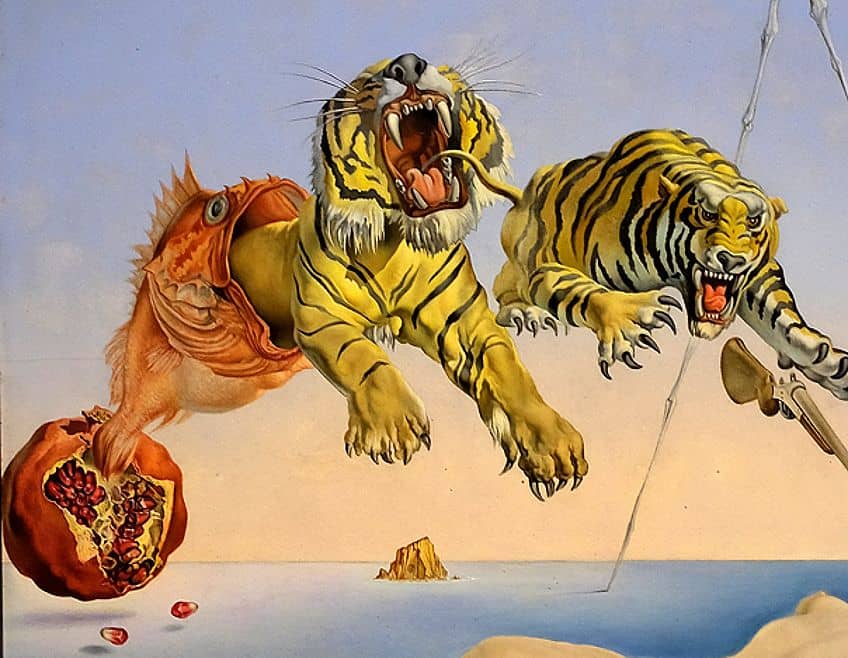
Near the pomegranate, a small bee flutters, acting as a catalyst for dreams, symbolizing fertility and industry. Droplets of water hover above Gala, creating a momentary suspense, while in the background, calm waters reflect tranquility, enhancing the overall atmosphere. Beneath Gala lies a flat rock, signifying stability amidst the dynamic elements of the painting, grounding the scene in a sense of solidity. Each positioning within the artwork adds layers of meaning, inviting viewers to delve into the complexities of the narrative and appreciate the subtle nuances of symbolism present throughout.
Cultural and Historical Impact
Salvador Dalí’s Dream Caused by the Flight of a Bee Around a Pomegranate a Second Before Awakening stands as a prominent example of Surrealist art that has significantly influenced both art and psychoanalytic communities, securing its place in renowned collections including the Fundació Gala-Salvador Dalí and the Museo Nacional Thyssen-Bornemisza.
Public and Critical Reception
Upon its unveiling in 1944, the painting immediately garnered attention for its vivid depiction of the subconscious mind, a central theme in Surrealist art. Critics praised Dalí’s skillful blend of realistic detail with fantastical elements, a hallmark of his technique.
Public reception mirrored this fascination, as viewers were drawn to the perplexing dream-like imagery and its Freudian implications, suggestive of the themes explored in Sigmund Freud’s The Interpretation of Dreams.
Legacy of the Artwork
Dalí’s painting has transcended time, maintaining its status as an iconic piece of Surrealist art. Its legacy is illustrated by the continued scholarly discussion it inspires, examining elements ranging from the Christian symbols present in the work to its autobiographical nuances. The artwork’s prominence is cemented by its inclusion in the collection of the Museo Nacional Thyssen-Bornemisza and the influence it has had on contemporary Surrealist artists. Beyond its cultural footprint, it remains a testament to Salvador Dalí’s enduring impact on the art world.

Salvador Dalí’s Dream Caused by the Flight of a Bee Around a Pomegranate a Second Before Awakening stands as a masterful exploration of the subconscious, employing surreal imagery and intricate symbolism to captivate the viewer’s imagination. Through its enigmatic composition, the painting prompts contemplation of existence, desire, and the human psyche. Dalí’s genius lies in his ability to evoke profound emotions and provoke introspection through art. As viewers engage with its mysteries, they are confronted with the boundless depths of the imagination. Truly, Dalí’s work remains a testament to his enduring legacy as one of the most visionary artists of the 20th century.
Frequently Asked Questions
How Is the Concept of Dreams Represented in Salvador Dalí’s Art?
In Salvador Dalí’s artwork, dreams manifest as vivid, often jarring juxtapositions of everyday objects and fantastical creatures, creating a bridge between the conscious and subconscious worlds. His painting, Dream Caused by the Flight of a Bee around a Pomegranate a Second before Awakening, specifically showcases this bridging by depicting a dreamlike state where physical laws are defied and rationale is suspended.
What Is the Significance of the Tigers and Pomegranate in the Artwork?
The tigers in this painting possibly signify primal instincts or threats erupting from the subconscious, while the pomegranate, commonly a symbol of fertility and rebirth, may represent the latent potential within the dream state. Together, these elements highlight a tension between creation and destruction, a recurring theme in Dalí’s surrealist works.
Isabella studied at the University of Cape Town in South Africa and graduated with a Bachelor of Arts majoring in English Literature & Language and Psychology. Throughout her undergraduate years, she took Art History as an additional subject and absolutely loved it. Building on from her art history knowledge that began in high school, art has always been a particular area of fascination for her. From learning about artworks previously unknown to her, or sharpening her existing understanding of specific works, the ability to continue learning within this interesting sphere excites her greatly.
Her focal points of interest in art history encompass profiling specific artists and art movements, as it is these areas where she is able to really dig deep into the rich narrative of the art world. Additionally, she particularly enjoys exploring the different artistic styles of the 20th century, as well as the important impact that female artists have had on the development of art history.
Learn more about Isabella Meyer and the Art in Context Team.
Cite this Article
Isabella, Meyer, ““Dream Caused by the Flight of a Bee” by Salvador Dalí – Analysis.” Art in Context. February 12, 2024. URL: https://artincontext.org/dream-caused-by-the-flight-of-a-bee-by-salvador-dali/
Meyer, I. (2024, 12 February). “Dream Caused by the Flight of a Bee” by Salvador Dalí – Analysis. Art in Context. https://artincontext.org/dream-caused-by-the-flight-of-a-bee-by-salvador-dali/
Meyer, Isabella. ““Dream Caused by the Flight of a Bee” by Salvador Dalí – Analysis.” Art in Context, February 12, 2024. https://artincontext.org/dream-caused-by-the-flight-of-a-bee-by-salvador-dali/.


